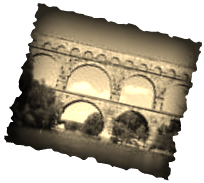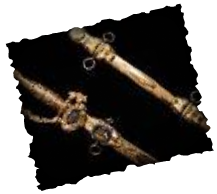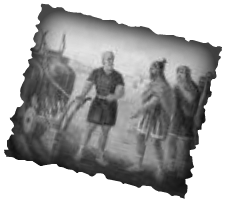Best places to see Roman technology
By: Mary Beth Hopkins
Colosseum

Opened in 80 A.D. and named after Emperor Nero's Colossus Statue, the Colosseum dominates the center of Rome. It is one of the greatest and biggest works of Roman architecture and engineering, but took less than a decade to build. Its beautiful architecture and dramatic flair make it perfect for a night out. It has four floors, three with arched entrances, the fourth with rectangular ones, and a total of 76 entrances. Depending on your gender and social status, you will be assigned a seat. The spectator capacity is 55,000 people! Not only that, but the building is well designed in case of emergencies. The entire audience can exit the theater in about 5 minutes.
The Colosseum is the number 1 place to go to see gladiator fights. Nets protect you from the gladiators and the animals. If you're lucky you can visit the Hypogeum, where they animals and gladiators are kept. It consists of many tunnels, animal pens, and vertical shafts, allowing direct access to the arena. The arena itself is covered in sand. Seats are filling up fast, so hurry! Visit the Colosseum today with GoRome!
The Colosseum is the number 1 place to go to see gladiator fights. Nets protect you from the gladiators and the animals. If you're lucky you can visit the Hypogeum, where they animals and gladiators are kept. It consists of many tunnels, animal pens, and vertical shafts, allowing direct access to the arena. The arena itself is covered in sand. Seats are filling up fast, so hurry! Visit the Colosseum today with GoRome!
Aqueducts

The Roman Aqueducts are one of the most advanced technological feats in human history. The aqueducts supplied enormous amounts of water to the city of Rome. Most of the 260 miles of aqueducts were located under the ground and used gravity to maintain continuous flow. They were built of stone, brick and volcanic cement that were impermeable to water. The Romans invented concrete and learned to build a row of arches to create a barrel vault that could support aqueducts. They also knew how to build domes without supporting columns.
The water in the aqueducts flowed into cisterns and later into lead pipes that supplied it to individual houses. A total of eleven separate aqueducts were built over 500 years. Not only that but the Romans had the most advanced indoor plumbing and sewer system in those times. So come on down to Rome and see the aqueducts!
The water in the aqueducts flowed into cisterns and later into lead pipes that supplied it to individual houses. A total of eleven separate aqueducts were built over 500 years. Not only that but the Romans had the most advanced indoor plumbing and sewer system in those times. So come on down to Rome and see the aqueducts!
Military weapons

The Military of Rome had some AMAZING weapons! Some of them included sharp swords and pointed throwing spears. They also developed scorpios (crossbow-like weapons), ballistas (catapult-like launchers), onagers (small ballistas), and of course, the classic catapult. The catapult was redesigned during the rein of Alexander the Great for his campaigns. It could use stones as heavy as 78 kilograms with considerable accuracy. The crossbows used a complex mechanism involving a rotating nut and lever. Not only that, but they had very well designed armor and shields to protect their own soldiers. The heavy armor was made up of overlapping iron plates and chainmail. To find out more about the military, go to the military link above. Come see the military soon with GoRome! This might be your only chance!
Farmers

The Ancient Romans considered farming an honorable occupation and wrote many books on farming and farm management. The Roman farmers used very unique inventions many of them made of iron. They had ards (soil breakers drawn by oxen), sickles, and scythes. They redesigned the sickle so that it wouldn't hurt the wrist. Not only that, but eventually they created a machine (scythe) to harvest large fields! Wow! They made lots of food because they had such a big empire and a lot of farming land. They used oxen and donkeys to plough and pull their harvester. In order to supply water they build an extensive system of dams, canals and reservoirs which were lined with waterproof cement. The Romans grew mostly cereal (bread), olives (olive oil), and vines (grapes and wine). They used water mills to mill their grain. The Romans used the wheel in their inventions. We do not know who invented it first but we know that the Romans made a very good use of it in water wheels and harvesters. So if you ever wondered how people used to farm, now is your chance to see it with your own eyes! You'll be glad you did!
Signaling Codes

The Romans fought many wars and kept adding new lands to their empire over several centuries. They had to develop a way of communicating without cell phones. They could not just text their soldiers while in battle. So they created some very complex signaling code systems for military purposes. One of them involved a series of flag raises, code books, and water timers. A guard would raise a flag and both him and another guard would start the water timers at the same time. They would wait, and when it was the right time, one person would signal the individual letters with the flag. The code books would tell the other person what he was saying. There were so many different types of codes. Later, in the eighteenth century, the French and the English started using similar codes.To learn more, travel back in time to Rome and see all the different types of signals and codes!
Contact Info
Mary Beth Hopkins, Head of Technology Department at GoRome. Graduate of NYU, Pro Historian.
[email protected]
Bibliography
Sources
“BBC history; Discovering Roman Technology.” http://www.bbc.co.uk/history/ancient/romans/tech_01.shtml (May 6, 2011).
“Crystalinks; Metaphysics and Science website.” http://www.crystalinks.com/romeaqueducts.html (May 6, 2011).
“eHow” http://www.ehow.com/info_8164168_materials_ancient_romans_use_farming.html (May 11, 2011).
“Maria Milani; Rome.” http://www.ariamilani.com/ancient_roman_technology.htm (May 6, 2011).
“Roman Weapons and Tactics.” http://www.richeast.org/htwm/Greeks/Romans/weapons/weapons.html (May 11, 2011).
“UNRV History; Roman Colosseum.” http://www.unrv.com/culture/colosseum.php (May 11, 2011).
Research Questions
Why were the aqueduct needed and what were they?
What types of weapons did the Roman military have and did they have any technical advancements?
What was the Roman's most advanced technological feat and why was it created?
What was the Colosseum and what was it used for?
Did the farmers have any special tool they would use to farm?
What types of machines did the Romans make to help them with their everyday lives?
Mary Beth Hopkins, Head of Technology Department at GoRome. Graduate of NYU, Pro Historian.
[email protected]
Bibliography
Sources
“BBC history; Discovering Roman Technology.” http://www.bbc.co.uk/history/ancient/romans/tech_01.shtml (May 6, 2011).
“Crystalinks; Metaphysics and Science website.” http://www.crystalinks.com/romeaqueducts.html (May 6, 2011).
“eHow” http://www.ehow.com/info_8164168_materials_ancient_romans_use_farming.html (May 11, 2011).
“Maria Milani; Rome.” http://www.ariamilani.com/ancient_roman_technology.htm (May 6, 2011).
“Roman Weapons and Tactics.” http://www.richeast.org/htwm/Greeks/Romans/weapons/weapons.html (May 11, 2011).
“UNRV History; Roman Colosseum.” http://www.unrv.com/culture/colosseum.php (May 11, 2011).
Research Questions
Why were the aqueduct needed and what were they?
What types of weapons did the Roman military have and did they have any technical advancements?
What was the Roman's most advanced technological feat and why was it created?
What was the Colosseum and what was it used for?
Did the farmers have any special tool they would use to farm?
What types of machines did the Romans make to help them with their everyday lives?
